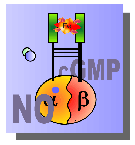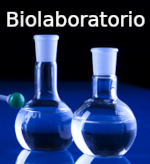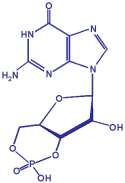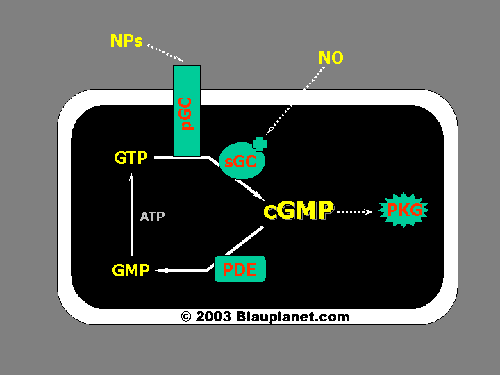
© Blauplanet.com
Other sections:





Cyclic GMP
Site
Created by Dr. Luis Agulló (last update on 28-12-2007)
Nitric Oxide/Cyclic GMP Pathway

Fig. 1. Simplified scheme of the cyclic GMP pathway. Cyclic GMP (in the center of the cell in the diagram) is produced (synthetized) from GTP, a guanine nucleotide triphosphate, both by soluble (sGC) and particulate (pGC) guanylyl cyclases (also known as guanylate or guanyl cyclases). Cyclic GMP is degraded by another group of enzymes known as phosphodiesterases (PDE). After degradation to GMP (a non-cyclic monophosphate), ATP as supplier of metabolic energy is required to obtain again the initial compound: GTP. Many of the effects of cyclic GMP are mediated by the protein kinase G (PKG), an enzyme that after activation by cyclic GMP is able to phosphorylate and change the function of different proteins. In the diagram it is also shown that sGC is activated by nitric oxide (NO) and pGC by natriuretic peptides (NPs).
Transduction pathways are complex cascades where many substances are implicated. The cyclic GMP signaling transduction system is not an exception. Here, we treat to introduce the components of this pathway (the 'actors') in a simple way. Some components are 'small' molecules (non-proteins) and the others are complex molecules (proteins) that, in general, participate in the transformation of the former substances.
The small molecules (non-proteins)
Cyclic GMP ("the classic"): The molecule that named this web site. It was discovered many years ago, but the regulation of its synthesis has remained obscure until very recently. It is a relatively complex molecule and very similar to another second messenger, cyclic AMP or cAMP. Both derived from two well known molecules in biochemistry: ATP and GTP. These two compounds are used in metabolic reactions for the exchange of metabolic energy and are composed by a sugar, a nitrogenous base and three residues phosphate.
Nitric Oxide or NO ("the famous""): One of the most singular molecules acting in cell signaling. It was difficult to accept for biochemists that this extremely simple molecule (a diatomic gas) and very reactive were really able to transport specific information from one cell to another. Now, after several years of intense work, we start to understand how this compound functions in our organism. Knowing its mechanism of action has allowed us to realize for instance why nitroglycerine, a drug that has being used for decades, can achieve symptomatic relief in patients with angina.
Natriuretic peptides or NPs ("the others"): Probably less known than nitric oxide, these molecules are also very important in the cyclic GMP pathway. They activate the other enzyme that makes cyclic GMP: the particulate guanylyl cyclase (pGC). These substances are completely different from nitric oxide. They are peptides, that is, chains composed by tens of aminoacids. For example, atrial natriuretic peptide or ANP, one of the activators of pGC, is made of 28 aminoacids.
Secondary actors: Many other substances play a role in the pathway; e.g. L-arginine, oxygen, calcium, cyclic AMP,…
The machinery (the implicated enzymes)
Nitric Oxide Synthases (NOS): They make nitric oxide from L-arginine (other substances are also necessary for this reaction to occur).
Guanylyl Cyclases (GC; also named guanylate cyclases and guanyl cyclases): They produce cyclic GMP.
Cyclic Nucleotide Phosphodiesterases (PDE): Proteins responsible for the degradation of cyclic GMP.
Protein kinases G (PKG): One of the mediators of cyclic GMP actions in the cell. They modify different proteins (adding a phosphate) after being activated by cyclic GMP.
Related Web Sites


Author: Dr. Luis Agulló (luis.agullo [at] lagullo.com).
Edited by Blauplanet.com, Cerdanyola del Vallès, Barcelona, Spain.
Webmaster: info [at] blauplanet.com. Conditions of use.